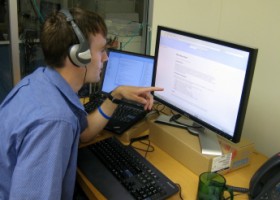REDMOND, Wash. – June 18, 2008 – When Jeff Bigham started developing a Web-based screen reader for people who are blind, he had no idea his work would bring him international recognition as one of the brightest young stars of computer science and accessible technology. He was just trying to help people.
Bigham, 27, and a Ph.D candidate in computer science at the University of Washington, won the first-ever Accessible Technology Award for Interface Design in the 2008 Imagine Cup technology competition sponsored by Microsoft. The award includes US$8,000 in prize money and a trip to the Imagine Cup world finals in Paris, July 3-8, where Bigham will demonstrate WebAnywhere, the winning technology solution he designed, and have the opportunity to share information with other outstanding Imagine Cup competitors.
“WebAnywhere, and the other excellent entries for the Accessible Technology Award, show that students around the world can be inspired to design innovative, accessible technology,” says Annuska Perkins, senior accessibility strategist at Microsoft and captain for the Accessible Technology Award.

Jeff Bigham works on WebAnywhere, a technology solution that makes any computer usable by people who are blind. Seattle, June 17, 2008.
A Screen Reader for Every Computer
WebAnywhere makes it possible for people who are blind to access information over the Internet from almost any computer. They don’t have to carry their own computer with them everywhere or install expensive screen-reader software. All they have to do is visit the WebAnywhere Web site (www.webanywhere.cs.washington.edu), which provides a screen-reader interface that translates Web-based text to speech and reads the content aloud.
Because of the cost of most screen readers — often $1,000 or more — and the difficulty of providing ongoing support, few public computers come equipped with the software, effectively making them unusable by people who are blind. Most public computers are locked down to prevent users from installing new software. As a Web-based application, WebAnywhere doesn’t require the installation of additional software, and Bigham’s screen reader is designed to work with any browser or operating system.
“One of the primary advantages of everything moving to the Web is that people can access information and applications anywhere, at any time, and from any computer,” Bigham says. “For people who use their computers in different ways — whether it’s a blind person who uses a screen reader, or someone with low vision who needs to see things magnified, or someone with a learning disability who requires information to be presented in a specific format — that advantage doesn’t exist.
“WebAnywhere solves that problem for people who are blind, and it’s easy to imagine how the technology could provide personalized views of any computer for people with other disabilities or preferences,” he says.
Founded by Microsoft in 2003 to encourage young people to visualize a better world enabled by technology, and to realize that vision by using their imaginations and technical skills to solve real-world problems, Imagine Cup is now the world’s premier technology competition for college and high school students. In 2008, students from more than 100 countries are competing for US$180,000 in prize money in nine invitational divisions, ranging from Software Design and Embedded Development to Photography and Short Film.
According to Perkins, with an increasing number of communities and governments around the world disseminating information and providing services online, having technology and Internet access at home, work, and in public places is becoming more critical for everyone. By giving people with visual impairments a new way to access information, WebAnywhere can help them make better informed decisions and take advantage of essential services.
“One of the scenarios we included in our submission was the idea of using WebAnywhere to look up the status of the next bus to arrive,” Bigham says. “In Seattle, we’re fortunate to have real-time online tracking of public buses. Knowing not only the bus schedule but also whether the bus is on time or delayed makes public transportation much more usable and, therefore, more likely to be used. With WebAnywhere, people who use screen readers can access this information from libraries and public kiosks, just like everyone else.”
Serious about Accessibility
Bigham says his Imagine Cup experience has inspired him to continue working on accessible technology and to find new ways to help people.
“The biggest thing I took away from the Imagine Cup is that it’s really cool they have this award at all. It shows that Microsoft is really serious about accessibility,” Bigham adds.
“I think it’s great that Microsoft gives students an opportunity to express themselves in a forum where they can compete and practice developing software. The Imagine Cup gives people an opportunity to be creative and imaginative. That’s great.”
After he receives his Ph.D next year, Bigham hopes to become a professor at a research institution. Meanwhile, he is planning to make WebAnywhere publicly available beginning this summer.
“My goals in the future are to continue doing research and working with students, and also to keep doing things that actually help people,” Bigham says. “That has been one of the cool things about this project: it’s not like we just did the study, learned some things, and that’s it. With WebAnywhere, we’re actually taking it to the next step and getting it out to people who need it.”




